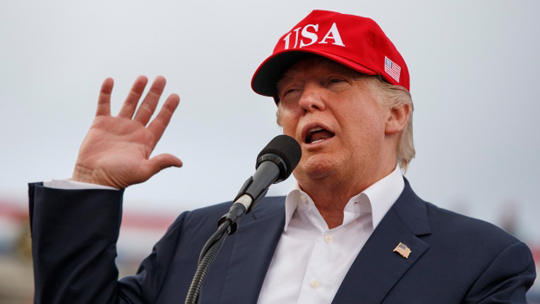Dec 18: President-elect Donald Trump says the US should let China keep the US Navy's unmanned underwater glider that it seized in the South China Sea.

Trump tweeted Saturday: "We should tell China that we don't want the drone they stole back.- let them keep it!" His tweet came after the US military announced it had reached an understanding with China for the return of the underwater glider.
On Saturday morning, Trump took to Twitter to blast China for, as he described it, ripping the research drone out of the water.
According to the Pentagon, the drone was seized Thursday while collecting unclassified scientific data in the South China Sea, which China claims virtually in its entirety.
The US military says that through "direct engagement" with the Chinese, it's "secured an understanding" that China's navy will return an underwater glider seized in the South China Sea.
Peter Cook, a spokesman for US Defense Secretary Ash Carter, says in a statement that the US had registered its objection to what the US is calling an "unlawful seizure" of the unmanned submerged device in international waters.
China says its navy seized a US Navy unmanned underwater glider to ensure the "safe navigation of passing ships."
Defense Ministry spokesman Yang Yujun issued a statement late Saturday saying that a Chinese navy lifeboat discovered an unknown device in the South China Sea on Thursday. It said, "In order to prevent this device from posing a danger to the safe navigation of passing ships and personnel, the Chinese lifeboat adopted a professional and responsible attitude in investigating and verifying the device."
The statement said that after verifying that the device was an American unmanned submerged device, "China decided to transfer it to the US through appropriate means."
It also accused the US of deploying "ships in China's presence to conduct renaissance and military surveying. China is resolutely opposed to this and requests the US stop such activities."
President-elect Donald Trump has corrected his spelling in a tweet blasting China's seizure of a US Navy unmanned underwater glider.
Trump put out a fresh tweet Saturday saying that the seizure of the drone was an "unprecedented" act. He earlier tweeted that the act was "unpresidented."
Last weekend, Trump tweeted that CNN reports "rediculous" fake news. Hours later, he put out a fresh tweet correcting the spelling to "ridiculous."
According to the Pentagon, the drone was seized Thursday while collecting unclassified scientific data in the South China Sea.
President-elect Donald Trump has blasted China's seizure of a US Navy unmanned underwater glider.
Apparently misspelling "unprecedented," Trump tweeted Saturday: "China steals United States Navy research drone in international waters - rips it out of water and takes it to China in unpresidented act."
Last weekend, Trump was criticized on social media for bad spelling in a tweet in which he accused CNN of reporting "rediculous" fake news. Hours later, he put out a fresh tweet correcting the spelling to "ridiculous."
According to the Pentagon, the drone was seized Thursday while collecting unclassified scientific data in the South China Sea, which China claims virtually in its entirety, about 92 kilometers (57 miles) northwest of Subic Bay near the Philippines.
A newspaper published by China's ruling Communist Party is citing a military officer as saying that China and the US are in contact over China's seizure of a US Navy unmanned underwater glider, and that a "smooth resolution" of the matter is expected.
The Global Times said Saturday that a Chinese navy ship discovered what it described as an "unidentified device" Thursday. The US has said it issued a formal diplomatic complaint over the drone's seizure and demanded its return.
According to the Pentagon, the drone was seized while collecting unclassified scientific data in the South China Sea, which China claims virtually in its entirety, about 92 kilometers (57 miles) northwest of Subic Bay near the Philippines.
Neither China's foreign nor defense ministries responded to questions from The Associated Press.





Comments
Add new comment